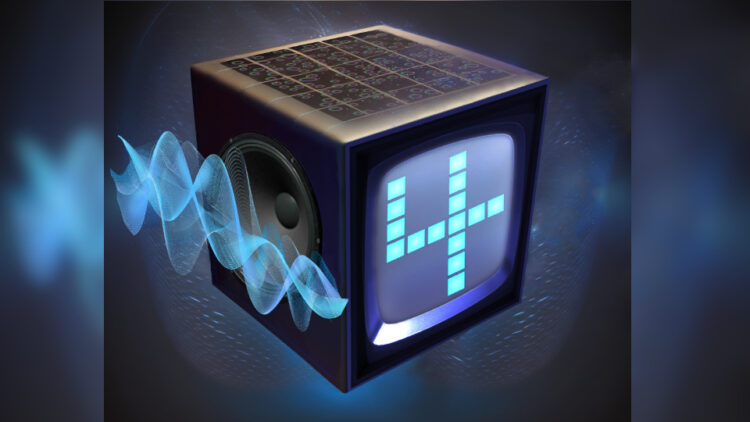Listen up, Material!

© UDE/Robin Msiska
“Seven, one, nine, …”: A human voice pronounces digits, a physical material recognizes them with about 97 percent accuracy.
This pattern recognition system was developed by physicists at the University of Duisburg-Essen (UDE) in collaboration with Ghent University (Belgium). The development enables multidimensional problems to be solved quickly and without energy-consuming training. The scientific journal Advanced Intelligent Systems published the results.
Is it possible for an inanimate material to recognize patterns quickly and efficiently? That was the question asked by a team of theoretical physicists, led by Professor Dr. Karin Everschor-Sitte. To prove their point, the researchers used speech recognition.
The team, including Robin Msiska as first author, used audio recordings of the spoken digits ranging from 0 to 9 from a standard database. The physicists analyzed the type and intensity of the frequencies involved for each moment of the spoken word. Subsequently, they converted this information into voltage signals, that they applied to a thin magnetic film via 39 contacts.
This thin film material contains small magnetic whirls (skyrmions) that react to the voltage by deforming. “To put it simply, you can imagine it as a black-and-white grid pattern that changes shape in response to input signals,” Msiska explains. The material thus forms unique patterns for each spoken number – like a QR code – which can be read out linearly with simple methods.
The team’s research utilized complex simulations, primarily carried out at the Flemish Supercomputer Center (Vlaams Supercomputer Centrum) in collaboration with Ghent University. Their material system correctly recognized 97.4 percent of the numbers. Examining only female voices, the figure rose to 98.5 percent. “This shows the best performance ever reported for in-material reservoir computers,” Everschor-Sitte is delighted to report. And it does so in the smallest of spaces; the sample the physicists worked with is just one micrometer in edge length.
“If one uses a neural network, training is expensive and requires enormous data sets. Our material system can solve machine learning problems without building a system of millions of interconnected neurons – the speech recognition shown here is just one example. It’s faster and uses less energy,” the physicist explains.
In her opinion, potential applications can be found where various signals need to be detected and interpreted: in autonomous driving, in weather forecasting, or in medical settings. In collaboration with other researchers at the UDE, their focus is currently on a standard medical examination: the electroencephalogram (EEG), which measures the electrical activity of the brain. The physicists are investigating whether the magnetic system can interpret these results independently.
Editor: Birte Vierjahn, +49 203/37 9-2427, birte.vierjahn@uni-due.de
Wissenschaftliche Ansprechpartner:
Prof. Dr. Karin Everschor-Sitte, Theoretical Physics, +49 203/37 9-4720, karin.everschor-sitte@uni-due.de
Originalpublikation:
http://doi.org/10.1002/aisy.202200388
https://www.uni-due.de/2023-03-27-material-recognizes-speech
Media Contact
All latest news from the category: Information Technology
Here you can find a summary of innovations in the fields of information and data processing and up-to-date developments on IT equipment and hardware.
This area covers topics such as IT services, IT architectures, IT management and telecommunications.
Newest articles

Compact LCOS Microdisplay with Fast CMOS Backplane
…for High-Speed Light Modulation. Researchers from the Fraunhofer Institute for Photonic Microsystems IPMS, in collaboration with HOLOEYE Photonics AG, have developed a compact LCOS microdisplay with high refresh rates that…

New perspectives for material detection
CRC MARIE enters third funding period: A major success for terahertz research: Scientists at the University of Duisburg-Essen and the Ruhr University Bochum have been researching mobile material detection since…

CD Laboratory at TU Graz Researches New Semiconductor Materials
Using energy- and resource-saving methods, a research team at the Institute of Inorganic Chemistry at TU Graz aims to produce high-quality doped silicon layers for the electronics and solar industries….



